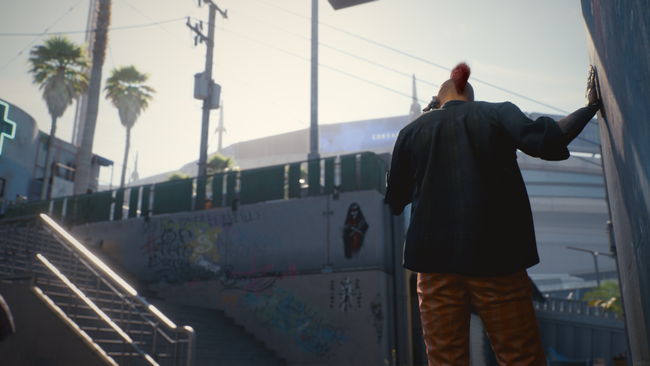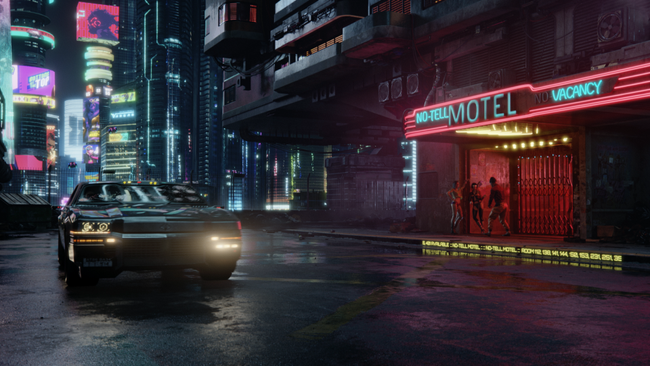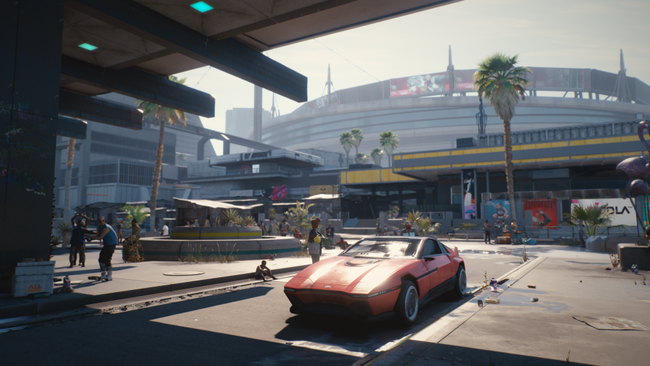
Cyberpunk 2077 Interview: Exploring the Environment with Senior Concept Artist Marthe Jonkers
At Gamescom 2019 we had the opportunity to meet with Senior Concept Artist Marthe Jonkers and discuss the process behind designing the sprawling cityscape of Night City in Cyberpunk 2077. While we at RPG Site were also able to check out the gameplay demo at E3 earlier this year, this sit-down illustrated just how much detail was put into the environments and atmosphere of Cyberpunk 2077.
RPG Site: Cyberpunk 2077 has a very grimy, neon aesthetic similar to art featured in the table-top manuals. What was your main inspiration and method when it came to incorporating these 80's era elements into the environments and character designs of Cyberpunk 2077?
Marthe Jonkers: That's a really interesting question because Cyberpunk 2077 is of course based on Mike Pondsmith's Cyberpunk 2020, which is the origin of the cyberpunk in our game, there is so much lore and story there, but a lot has happened in the 50 years between. It's also not like Cyberpunk 2077 is the future of our world, but the future of Mike Pondsmith's world so we took that as an inspiration. Also, I guess in our visual style, here and there you can kind of see some references to Mike Pondsmith's table-top game - we have the jacket with the lights and stuff, but we also wanted to make something unique and make our own cyberpunk world.
We did that by taking a look at the timeline between 2020 and 2077, and connecting certain fashion styles and architecture styles to it like in the real world, like 70's styles or 80's. They're very different in aesthetics, but we wanted the same for our game so we would have this realistic place to work from. The posters you see on the wall there, they represent the four styles which are the backbone of our visual design and they are really connected to this timeline which gives it this extra layer of realism. The first style is called entropism and that is connected to a time in the Cyberpunk lore when it wasn't great - people were poor, it wasn't a happy time. So the aesthetic from that time is very practical. They made things practical, not so many decorations. It just had to work. You can see it in the architecture, the fashion, and the vehicles.
The color palettes are subdued, there are harsh angles there, the material is very cheap, so this reflects the mood of that time. Then you have the second style which is called kitsch and this is when things were getting a lot better. First, you had this economic depression and times were getting better. Things were improving and in that age, you can see people are wearing much more colorful clothing; even the cars and buildings had brighter colors. People were really happy and wanted to express that. You see that in the style - the angles are more rounded and there are softer shapes. So now if you drive around Night City for instance and you see a building that's bright yellow and the windows are really rounded then you know it's kitsch style, so you kind of know how old the building is and you know who build it.
So with these styles, we tried to add layers to the city to make it more believable. We have four in total, I just mentioned the first two but we also have neo-militarism which is very corporate and we have the newest style, neo-kitsch, which is for the super-rich because in the recent age the gap between the poor and the rich is getting bigger and bigger so the super-rich kind of define their own style. It's a little bit like kitsch, so it's very colorful, but it has this extra level of natural animals because in Cyberpunk 2077 a lot of animals are extinct so if you can afford to have an animal print on your clothing you must be really rich. If your house has wooden panels you must be someone from the upper class. In this way, we wanted to give our visual design some kind of lore and backstory and make the city more believable.
RPG Site: This is all very interesting. So would you say that, for example, you mentioned kitsch, which is an actual art style and fashion movement inspired the visual story-telling of that era within the Cyberpunk universe?
Marthe Jonkers: Yes, but let me use the Watson District as an example. We showed that area in the first demo last year and Watson is very colorful because you'll see a bit of the history of that district. We're telling a story by using these styles and it's because Watson was destroyed by an earthquake at some point in history and was rebuilt. So you will see buildings that are very much in the entropy style but you'll also see a mixture of the second style, kitsch. You can see this timeline. They started building and these new trends came up so you see these layers on top of it so you see this history in the neighborhoods just through these visual styles. You really feel like you're in a real city, because when you walk around Cologne for example you see a mixture of styles you won't see one style, not just in the architecture but even in the cars and what people are wearing.
RPG Site: What were your main methods of research when designing Night City and were you inspired by any real, pre-existing architectural concepts?
Marthe Jonkers: I worked a lot on the districts and visual design, so designing a city is not easy, that's for sure. So we have six districts and they are all very different, because like in The Witcher you had these areas that had their own personality. We wanted to do the same for Night City so it wouldn't be very boring or repetitive, so when you drive around and explore the city it's exciting. I'll talk about Watson again because it's a very good example. It's a very Asian inspired district so you will see elements there that might remind you of Japan or China for example, so that was a huge inspiration, but we made sure to add this layer of Cyberpunk 2077 to it.
So it's always something you might recognize, and when we give it this twist we add maybe one of the styles to it or make it more cyberpunk so it's not literally Japanese architecture. It was a base inspiration for a couple of these neighborhoods but we wanted to show that this isn't our timeline, this is also in the future and it's heavily based on Cyberpunk 2020 so it had to be unique. I hope people will see that, that they might feel like this is some kind of Chinese structure but it isn't because it has one of these four styles layered on top of it.

RPG Site: When conceptualizing levels in the city did you ever create or use table-top as references to test city layouts or blueprints for the city?
Marthe Jonkers: It was interesting when we designed Night City, it's of course based on 2020, but we actually had an urban planner on our team that really helped us create this layout. It was also to make sure that you always had cool views or you always know where you're going, it was really tough actually because it can quickly become very confusing if you can't really see where you are. The composition was very important for that. As for level design, I'm not a level designer but I'll try to answer the question because I work with these guys, but what's really awesome is that you can play each level with very different play styles. Of course, they'll make a lot of different versions and test them.
Actually, there is a lot of back and forth between us and them. They'll come to us with a super cool gameplay layout and it'll just be a bunch of grey boxes and we come in and paint it over and make it look like some super cool abandoned warehouse and then the environment team will come in and build it. But in the context of Cyberpunk 2027, yeah, I guess the approach to designing a level is maybe thinking of an area in 2020 and thinking of a map or a layout and you start building from that.
RPG Site: That's really cool that you have a city planner helping you out with creating the layout for Night City.
Marthe Jonkers: Yeah. It really helps and it's really great. You need someone who thinks about the layout, the map and how the roads will go and what is realistic.
RPG Site: What the biggest challenge in designing Night City and setting apart as it's own unique scenario separate from Cyberpunk 2020.
Marthe Jonkers: Actually, it really helped to have 2020 as a base because this game has so much backstory and lore, and it really helps when you have to design a city. When you don't have that, it'd be extremely difficult. But we have Mike available to ask him stuff and get all of this background information and get this timeline so we know how everything developed. You have a really strong base to design a city, but it still isn't easy and we're making this game out of it that brings a lot of new challenges with it. We really wanted those six districts to be different but on the other hand, it needs to feel like one city. They are very different, Pacifica the one we showed this presentation is different from Watson that we showed last year, however, it's still one city and those visual styles really help because it binds Night City as one world and one setting. We also put a lot of effort into the areas between the districts for instance, we made sure these areas flowed together in a very natural and believable way. This was actually one of the more difficult things - to make it feel similar but also the same.
RPG Site: Pacifica has a very large Haitian population. When designing that area did you look at any cultural reference from Haiti when creating this area?
Marthe Jonkers: Well if you know the backstory of Pacifica, to summarize it this was an area that was supposed to be a resort area and corporations withdrew the money because of an economic crisis, the area was perfectly fine but no one wanted to live there, and at the same time Haiti in our timeline - our Cyberpunk timeline - was almost unlivable because of natural disasters that's why the Haitian community moved to Pacifica. It was a perfectly good area and they could make a living there, even better that the corporations aren't there because they don't want anything to do with them. So it's like an alternate timeline and they made a living there. The Voodoo Boys are the gang that's in charge there, and what's really cool is that we had a lot of talented artists that made the graffiti for the different gangs and we did a lot of research into their backgrounds and what kind of style they would have. We made sure that all of the gangs have their own visual style and you'll see it when you play the game. It adds an extra layer of believably to the area - Pacifica is not just an abandoned area, you can see that they made a living there and you can see their art styles over the walls. You can see this place has a history. We tried to combine all of these visual cues to make the city feel as real as possible.

You can find more of our Gamescom coverage of Cyberpunk 2077 here. Interested in even more Cyberpunk 2077 content? Don't worry, we have you covered.
Cyberpunk 2077 will release on April 16, 2020.
